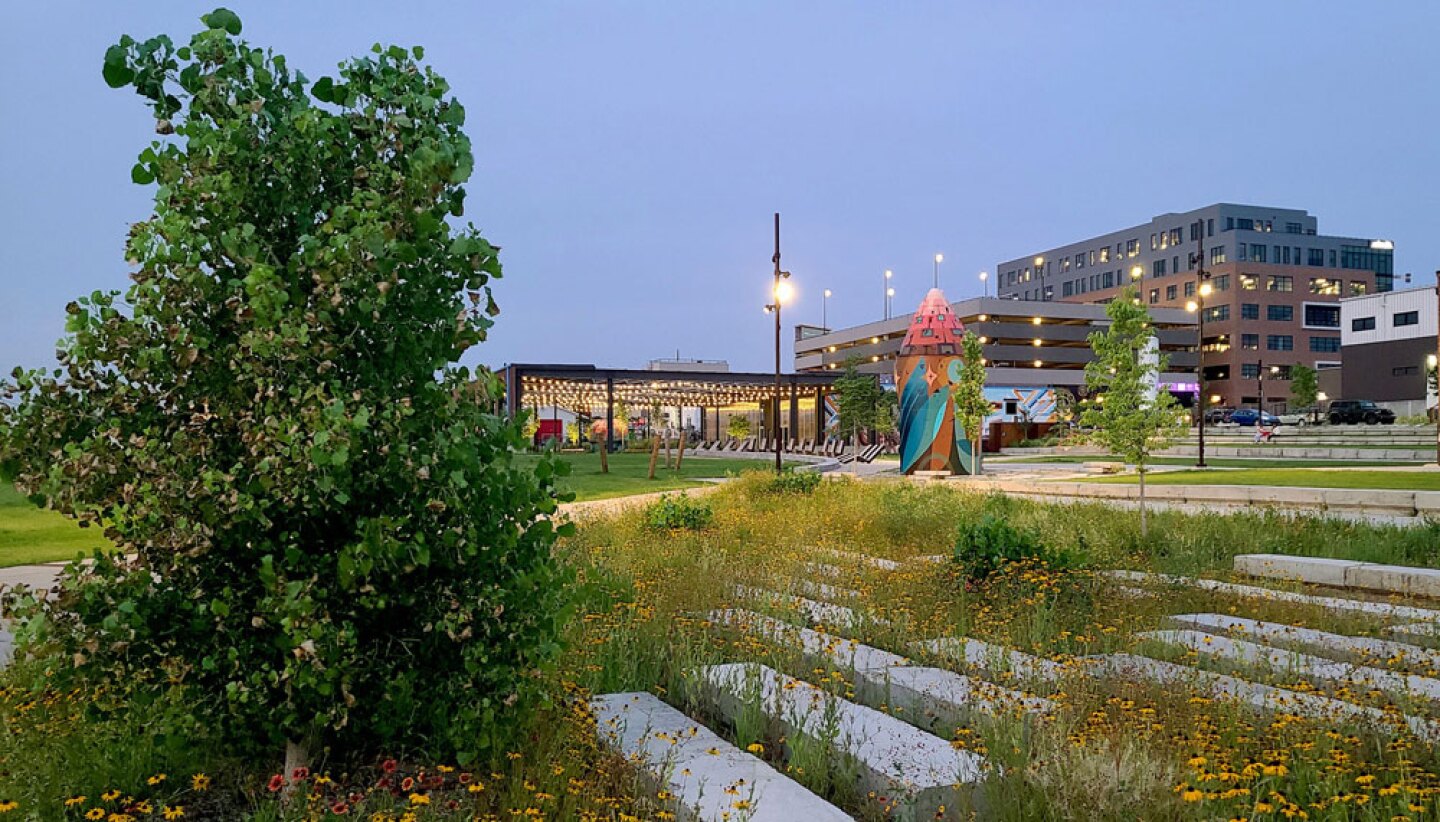Extreme weather events such as droughts and floods significantly impact vulnerable communities across the country—especially in places where the population continues to grow, creating even more tension between real estate demand and the risk of catastrophic flooding or drought. The good news is that shaping real estate projects around water-wise and flood-resilient measures can greatly mitigate water-related risks—and greatly enhance asset value at the same time.
A session titled “Water: Too Much and Too Little—Strategies for Climate-Resilient Built Environments” at ULI’s 2025 Spring Meeting in Denver, Colorado, featured speakers Marianne Eppig, senior director of Resilience for ULI, and Greg Dorolek, principal of Wenk Associates. Together they shared best practices and case studies of how to cut down on water usage during droughts and mitigate flooding during excessive rains.
Strategies for water-wise built environments
In response to growing water scarcity, many communities around the world are shifting their focus from supply-side water strategies, such as dams and diversions, to demand-side water strategies, like water conservation, efficiency, and reuse—since demand-side strategies are far more affordable and environmentally friendly. They enable real estate developers and communities to limit overall water usage by getting rid of inefficiency and waste, saving money from lower energy and water use.
Water-wise strategies for built environments include:
- Infill development in areas with adequate water availability
- Low-flow and WaterSense-labeled fixtures
- Water-efficient appliances
- Smart metering and sub-metering
- Leak detection and repair
- Water reuse systems
- Drought-tolerant landscaping with native plants
- Permeable pavement
- Protection and restoration of groundwater and watersheds
Strategies for flood-resilient built environments
ULI members came up with the framework “Slow, Store, and Restore” to help communities cope with the increasing frequency and intensity of flooding. The idea is to first slow down fast-moving stormwater to reduce flood damage. Water can then be more easily stored, either in the landscape or temporarily in detention/retention systems, reducing impact on stormwater infrastructure and subsequent flooding. Finally, restoring urban ecosystems can improve absorption and groundwater recharge, while providing other benefits such as urban cooling, enhanced biodiversity, and improved air quality.
Other specific flood-resilient strategies for built environments include:
- Dry flood-proofing (prevents water from entering the building)
- Wet flood-proofing (allows water to enter and exit the building safely)
- Water-resistant materials
- Elevation of entire building
- Elevation of first floor
- Flood-resistant elevators
- Elevation/relocation or hardening of utility systems
- Backup on-site power (e.g., solar plus battery storage)
- Road raising
- Green infrastructure
- Restoration of natural riverbanks and ecosystems
- Flood barriers and berms
- Water retention features
- Limit development in high-risk areas
Case studies in the Denver area
By adding appropriate green infrastructure to urban areas, it’s possible to address both water scarcity and flooding. The following case studies shared by Greg Dorolek of Wenk Associates demonstrate how landscapes can incorporate water-wise and flood-resilient measures into real estate projects.
Denver’s TAXI II redevelopment project transformed the site of a former taxi dispatch center into a thriving, high-density, mixed-use community. Previously a landfill within a light-industrial neighborhood along the South Platte River, the terrain was extremely flat. Traditional piped stormwater drainage, as proposed by the project’s civil engineer, would have been costly, so the developer engaged Wenk Associates to rethink the landscape and develop more innovative and cost-effective solutions to the site’s infrastructure challenges.
The site was comprised of sandy soils just beneath the surface, which led to a strategy to utilize all of the site’s landscaped areas for stormwater infiltration. Stormwater gardens direct runoff from buildings and paved areas to native landscapes where it is absorbed; no subsurface piping was used. The landscape areas are designed to thrive in both dry and wet conditions, mirroring the South Platte River’s riparian ecosystem. Over the past 20 years, the TAXI development has expanded through multiple phases to include diverse housing types, office spaces, and community amenities, all supported by this unique landscape infrastructure.

The Arkins (RiNo) Park and Promenade links a series of outdoor rooms with walking and cycling access to numerous amenities, including theater, public art, gathering and play areas, an elevated river walkway, and seated overlooks. The landscape areas treat and infiltrate stormwater runoff, improving the water quality in the South Platte River.
(Wenk Associates)
Denver Parks and Recreation and the North Denver Cornerstone Collaborative (NDCC) determined that a new park was needed in the emerging River North (RiNo) neighborhood. The city envisioned the park to be a direct reflection of the up-and-coming arts district—an intimate, creative, and iconic park that would highlight the sustainability, arts, and culture of the surrounding neighborhoods, as well as enhance the ecology of the river corridor in new and creative ways.
Wenk Associates led a multidisciplinary team in preparing a master plan and construction documentation for the 3.5-acre (1.4 ha) linear park and promenade along the South Platte River. The resulting Arkins (RiNo) Park and Promenade links a series of outdoor rooms with walking and cycling access to numerous amenities, including theater, public art, gathering and play areas, an elevated river walkway, and seated overlooks. The landscape areas treat and infiltrate stormwater runoff, improving the water quality in the South Platte River.
Innovative approaches to managing stormwater within the park include directing runoff from streets, buildings, and pavement to shallow, vegetated swales that provide rapid infiltration through the native, sandy soils. A majestic 400-foot (122 m) steel gangway (designed by Tres Birds), and a playground and site elements made of recycled/reused materials, help create a unique identity for the RiNo community and Denver as a whole.
This project won a 2023 ULI Colorado Impact Award in the Inspire Category.
Baseline Parklands Pollinators & People
Baseline, a new 1,100-acre (445 ha) development in the arid high plains of Broomfield, Colorado, is designed to minimize water usage by maintaining native landscapes—saving money while creating a beautiful environment. Wenk Associates served as the landscape architect, melding the original site’s agricultural and rural past with the community’s future as a thriving urban center.
Baseline’s parklands are the development’s primary gathering place for recreation and leisure. The master plan orients the grid of the streets perpendicular to the Preble Creek corridor, where wetlands and native landscapes will be constructed to treat and manage stormwater runoff while also restoring the creek’s damaged floodplain. The naturalized corridor along Preble Creek integrates a network of secondary and tertiary trails with the regional stormwater detention, providing diverse opportunities for passive recreation. The Central Park accommodates picnicking and play areas, a water feature, and access to natural pools along the creek.
An invertebrate zoo, The Butterfly Pavilion, is planning to relocate to the Creek corridor. Wenk Associates collaborated with project stakeholders, including Butterfly Pavilion staff, to create district pollinator guidelines for landscape design, installation, maintenance, and monitoring. These guidelines are the first of their kind in the country for a large-scale development. They require designing for and actively managing invertebrates for the health of the ecosystem, and are internationally promoted as a model for sustainable development.
With the use of native landscaping, Baseline has reduced water use by about 50 percent compared to a typical irrigated landscape. The landscape has also supported a 63 percent increase in pollinator families. The water savings alone are projected to be $7.2 million over 10 years. As of today, the project is one-quarter developed, with an anticipated 20,000 residents upon completion. The water-wise, native landscapes in the project’s parks and open spaces have been key factors to the success of the development as reflected in residential surveys and community meetings.
Additional ULI resources:
- ULI’s Water Wise Development Coalition
- Water Wise: Strategies for Drought-Resilient Development
- ULI’s Developing Resilience Toolkit
- Harvesting the Value of Water: Stormwater, Green Infrastructure, and Real Estate
- Cloudburst Infrastructure Report
- CRE Guide to Natural Hazards and Property Insurance Underwriting
- Developing Urban Resilience case study website








